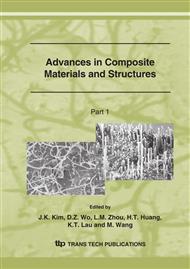p.1141
p.1145
p.1149
p.1153
p.1157
p.1161
p.1165
p.1169
p.1173
Poly(lactic acid) Composites Directly Molded from Lactide and Particle Fillers
Abstract:
Polymer composite samples consisting of L-Lactic acid (LA) was reacted by ring-opening polymerization with aluminum triflate as a catalyst, glycerol as an initiator and various particles as fillers. Cellulose particles, kaolin and silica gel with different particle sizes were employed as fillers. Filler content was varied 0 to 100 wt% as ratio of filler weight to PLA weight. L-Lactide (L-LA), aluminum triflate as catalyst, glycerol as an initiator and particles were mixed at room temperature and then were put into plastic tubes. The mixture in tubes was heated and reacted at 100 oC for 6 hours. The samples were removed from tubes after cooling and were cut into the column shape specimen with diameter of 10 mm and ca. 10 mm height. By the above procedure, particles could be mixed to poly(lactic acid) (PLA) matrix easily and homogeneously. The molecular weight and molecular weight distribution of PLA matrix were determined by gel permeation chromatography (GPC). Apparent density of composite samples was calculated by using weight and sizes of column shape specimens. The mechanical properties such as elastic modulus and strength were investigated by compression tests using column shape specimens. Molecular weight and molecular weight distribution were almost constant for all the samples with and without particles. Elastic modulus and compression strength were improved by particles. For the cellulose particles filled samples, the highest values of elastic modulus and compression strength were derived at filler content of around 20 vol%. The influences of sizes and types of particles on the physical properties such as molecular weight, density and mechanical properties were investigated.
Info:
Periodical:
Pages:
1157-1160
Citation:
Online since:
March 2007
Authors:
Price:
Сopyright:
© 2007 Trans Tech Publications Ltd. All Rights Reserved
Share:
Citation:


